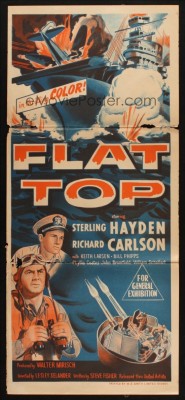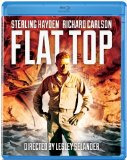| Reviews & Columns |
|
Reviews DVD TV on DVD Blu-ray 4K UHD International DVDs In Theaters Reviews by Studio Video Games Features Collector Series DVDs Easter Egg Database Interviews DVD Talk Radio Feature Articles Columns Anime Talk DVD Savant Horror DVDs The M.O.D. Squad Art House HD Talk Silent DVD
|
DVD Talk Forum |
|
|
| Resources |
|
DVD Price Search Customer Service #'s RCE Info Links |
|
Columns
|
|
|
Flat Top
Mirisch's clever cheat had its origins in one of his early successes, Flat Top (1952), a not very good propaganda piece about Navy Carrier Pilots, linking its WWII attitudes of teamwork and duty to the then-current Korean War. Chock-full of war movie cliches and stereotypes, as drama it pretty much stinks, but for its extensive use of Navy combat footage, military buffs should find it irresistible while film buffs might enjoy it as an intriguing anomaly.
What's most anomalous about Flat Top is that Monogram Pictures, the Poverty Row studio that normally spent $30,000-$90,000 on its ultra-cheap movies, produced this comparatively big budget (probably around $700,000) film. Mirisch had helped establish Allied Artists, Monogram's slightly classier subsidiary, in 1946. Wanting to shed its dirt-cheap image, Monogram eventually changed its name to Allied Artists for good, in 1953, though it continued making mostly low-end pictures. Flat Top was one of Monogram's last releases, and by their standards it's quite opulent, though ordinary by big studio standards. Mirisch, still around at age 91, liked to call movies like Flat Top "B-plus" pictures, but this is like a "nervous-A." (To me it's vying for the top of the bill, not just a high-end second feature.) What's more it's in Cinecolor, the poor man's Technicolor.
Most of the Monogram library now resides at Warner Bros., with scattered odd titles owned by MGM and Paramount. This reviewer has no idea how Paramount got its hands on Flat Top, but the high-def transfer courtesy Olive Films is spectacularly good, considering. One shouldn't expect The Wizard of Oz or Singin' in the Rain splendiferousness, but taking into account the technical limitations and preservation problems of Cinecolor, Flat Top is positively glorious.
Though set mainly in 1944-45, the movie is bookended by scenes set in the present, during the Korean War, drawing obvious parallels. Aboard the USS Princeton (CV-37), Dan Collier (Sterling Hayden) reminisces about his tour of duty aboard the same ship during the last war. In 1944 (in fact, before the real Princeton was launched) Dan is a by-the-book squadron commander of fresh-out-of-training ensign pilots.
Most of the drama concerns the conflict between hard as nails Dan and kind-hearted executive officer Joe Rodgers (Richard Carlson), who has stuck by his men since basic training. They look up to Joe and take an immediate dislike to Dan, especially after Dan orders Joe to permanently ground Barney "Oldfield" Smith (Keith Larsen) for landing his plane on the aircraft carrier (the "flat top" of the title) even after being waved off. Barney is devastated, particularly after receiving a letter from his father telling him how proud he is of his flyer son.
The other pilots are all standard types: Red Kelly (William Phipps), a singer; "Snakehips" McKay (John Bromfield), a football star; Longfellow (William Schallert), a starry-eyed, would-be poet; Judge (Todd Karns), a law student. All that's missing is "Cookie," a short-order cook. I guess Sid Melton was busy that week.
Eventually, of course, the pilots and even Rodgers eventually see the wisdom of Dan's super-strict disciplinarian ways, and the dangerous pitfalls of Joe's gentler leadership. Part of Douglas MacArthur's invasion force to retake the Philippines, the flyers shoot down innumerable Japanese Zeros while, for most of the film, the squadron suffers no losses. In a nice if familiar touch, they come to view their incredible good fortune as a kind of curse. Soon most of the men become superstitious that their luck could dramatically change at any moment.
Flat Top, however, is less interested in these human stories than the endless but spectacular combat footage, much of it POV aerial footage of the fighters shooting down Japanese Zeros. Particularly good are amazingly clear aerial views looking straight down on a Japanese air base in the Philippines as it's bombed (in fact footage of the bombing of Leyte Gulf). There's also some incredible footage of planes making hard or crash landings on the carrier. The picture's editing (by William Austin) earned Monogram a rare but deserved Academy Award nomination.
Trade papers reported Flat Top was to be shot on location at Pearl Harbor, in Hawaii, and, oddly, also in Canada, as well as aboard the Princeton, but it's painfully obvious only a second unit crew filmed aboard the carrier. All of the scenes on deck with the actors clearly and sometimes badly use process screens and modest soundstage sets are used for scenes below deck.
Hayden and Carlson were big stars by Monogram standards, Hayden having starred in MGM's The Asphalt Jungle while Carlson had been a second lead at Universal. Carlson's star was fading somewhat (though soon bolstered by his association with the emerging sci-fi genre, both as an actor and director) while Hayden's was on the ascent, though his past membership in the Communist Party and eventual testimony before HUAC (which he later profoundly regretted) seriously damaged his reputation. Watching Flat Top, I kept thinking the movie might have been better had Hayden and Carlson switched parts.
Actors who generally worked in low-budget movies during this period populate the rest of the film. Adventures of Superman stars Phyllis Coates and Jack Larson have small parts, she in a blonde wig playing Dan's wife in an awkwardly-inserted scene, he as a young sailor spreading scuttlebutt. William Schallert, quite busy during the early fifties, has an atypical and substantial role, while James Best, Hawaii Five-O creator Leonard Freeman, and Green Acres' Alvy Moore fleetingly appear in uncredited bits.
Video & Audio
Flat Top, in its original 1.37:1 format, was shot in Cinecolor, a bi-pack process (compared to Technicolor three-strip system) in which two strips of film were loaded into an ordinary 35mm camera, one recording magenta (purplish-red) and the other cyan (greenish-blue). The results, according to Wikipedia, "produced vibrant reds, oranges, blues, browns and flesh tones" but struggled with greens, yellows, and purple. In other words, Cinecolor was generally a good and inexpensive process for Westerns and war movies like this, less so for musicals and jungle pictures. Because of the way it was processed and printed, Cinecolor movies haven't survived as well as other color movies, and rarely look good today. Flat Top, however, shows off Cinecolor at its best: much more natural yet vibrant than anything I've yet seen in the process. (Warner Archive's Abbott and Costello Meet Captain Kidd, made the same year, also looks terrific, but that's a standard-def DVD.) The process's limitations are sometimes apparent, such as pinkish artillery fire emanating from the Princeton's big guns, but otherwise this gets high marks. The DTS-HD Master Audio mono (English only) is likewise perfectly fine; there are no subtitle options, and no Extra Features.
Parting Thoughts
Not great but extremely interesting for reasons other than the script, Flat Top is definitely worthwhile and Recommended.
Stuart Galbraith IV's audio commentary, for AnimEigo's Tora-san DVD boxed set, is on sale now.
|
| Popular Reviews |
| Sponsored Links |
|
|
| Sponsored Links |
|
|
| Release List | Reviews | Shop | Newsletter | Forum | DVD Giveaways | Blu-Ray | Advertise |
|
Copyright 2024 DVDTalk.com All Rights Reserved. Legal Info, Privacy Policy, Terms of Use,
Manage Preferences,
Your Privacy Choices | |||||||
















